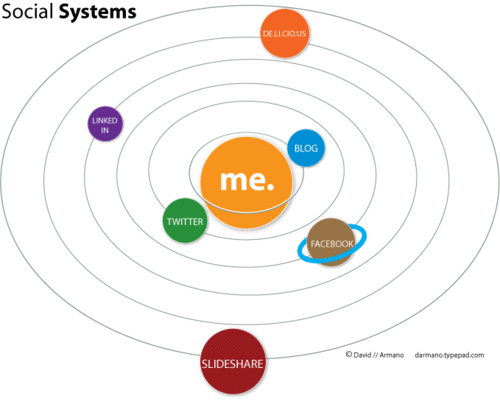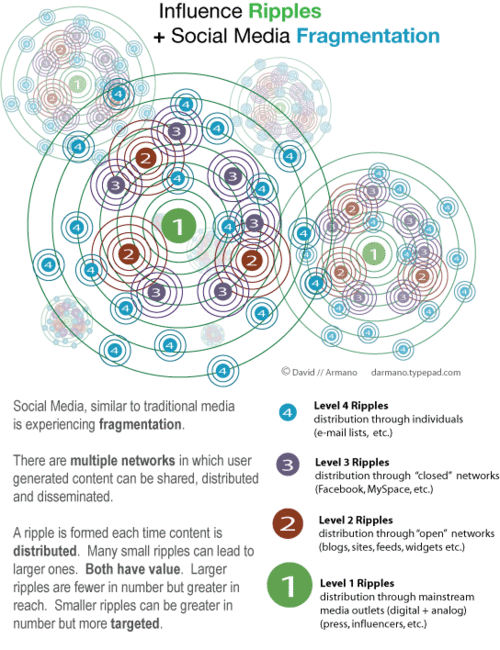Social Systems
Posted on Monday, January 7, 2008

Space makes for great metaphors, but sometimes they can seem just a little bit off. The image above I read, but what about this text:
The related concept of a "social graph" is difficult to explain, but social systems is easy. Many of us are now managing multiple social ecosystems. If you think of these as planets—some rotate in closer proximity to us. We "warm" them with our attention frequently. Others may orbit at further proximities—but they are still in our social systems. When we abandon a social ecosystem that we can no longer sustain, it drifts away from our orbit and dies. Many of us have had these experiences.
The blogpost does link to another interesting post about Influence Riples though. The pond metaphor seems to be better suited here:

This post's comments also includes another metaphor:
The ripples metaphor is fun, but it is passive and therefore has metaphorical limits.I prefer a bonfire metaphor.
Traditional push-marketing is like a huge organised bonfire. Marketers go to all the trouble of gathering tinder and firewood and inviting people to watch. Then they light the bonfire and stand back as the flames roar and the firewood crackles. Those invited get to enjoy the heat and the spectacle, those a little further away, to enjoy the dancing flames. Those much further away probably don't know there even was a bonfire. And once the bonfire has burnt itself out, all there is left are a few glowing embers and lots of ash.
Social marketing on the other hand is like a network of hilltop bonfires. Lots of different people prepare a limited number of small bonfires. Anyone can start a bonfire and then others on other hilltops can light their own bonfires and so the message spreads. Many people get to enjoy a bit of local heat with their friends and to see the flames flickering on many hilltops. They may even get to feel that they are part of something bigger. And the reach of the bonfire is potentially endless. It only depends upon how many people are willing to light their own bonfires to spread the message.
The metaphor is useful in a number of ways. Firstly, it shows that many small bonfires can reach much further than a large bonfire. Secondly it shows that anyone can light a small bonfire to spread the message to others. Finally, and most importantly, it shows that all these many small bonfires need to be built before the message can spread. If you wait until you see another hilltop bonfire befire you build your own it will be too late. The preparation necessary before a message can spread effectively is one aspect of social media that many commentators forget, in the rush to laud the role of the influencer in propagating social memes.
Back in the real world of influence, it seems to me that traditional marketing and social marketing need each other. Traditional marketing builds category need and awareness (to use the funnel analogy), whilst social marketing enlists those with an interest to spread it further and builds intention to buy. This complementarity is implicit in the p (adoption = traditional marketing) and q (imitation = social marketing) variables in innovation diffusion models in common use for over 50 years!
Keep up the metaphorically enlightening work.
It also links to the following insightful presentation:
